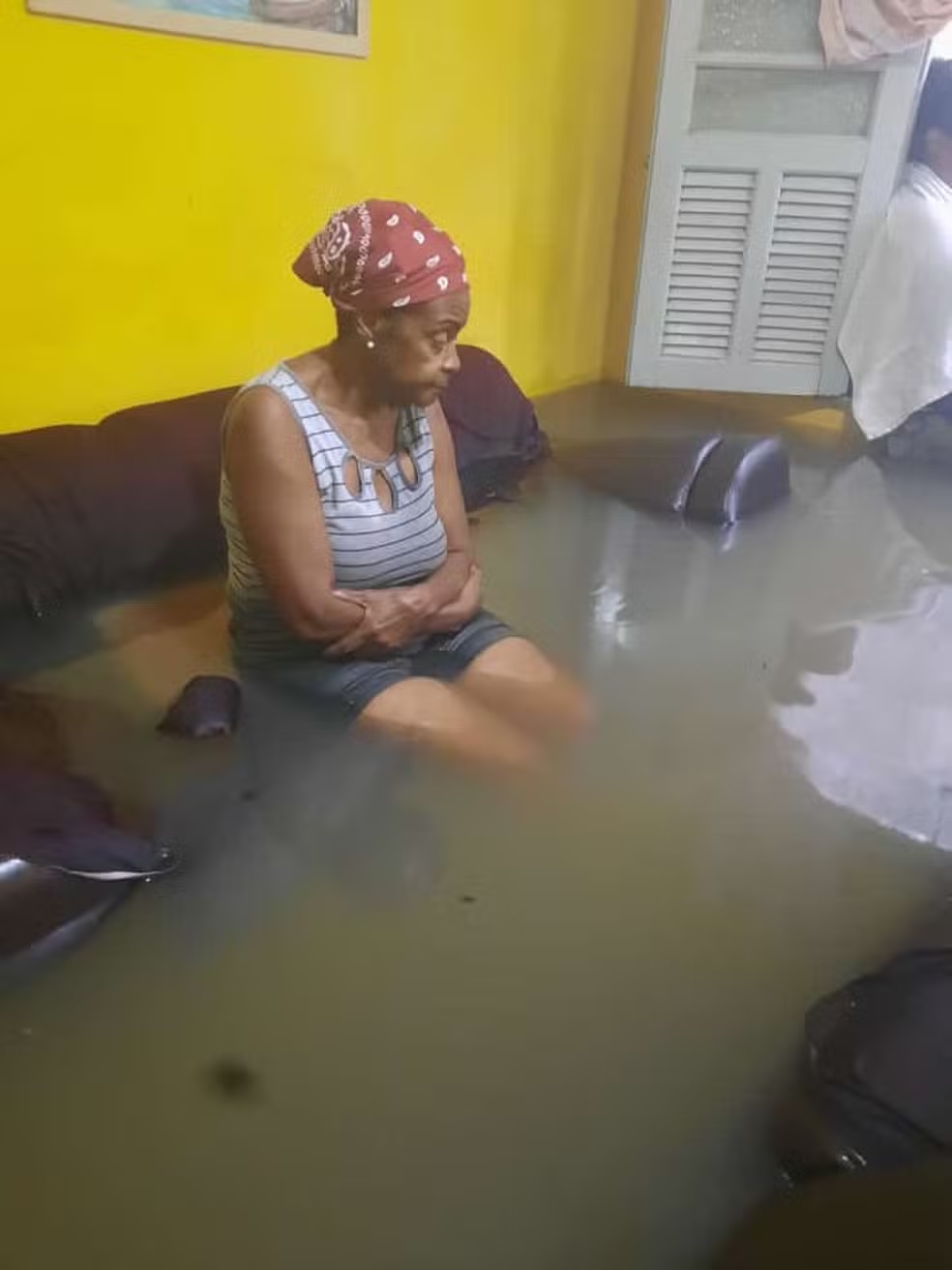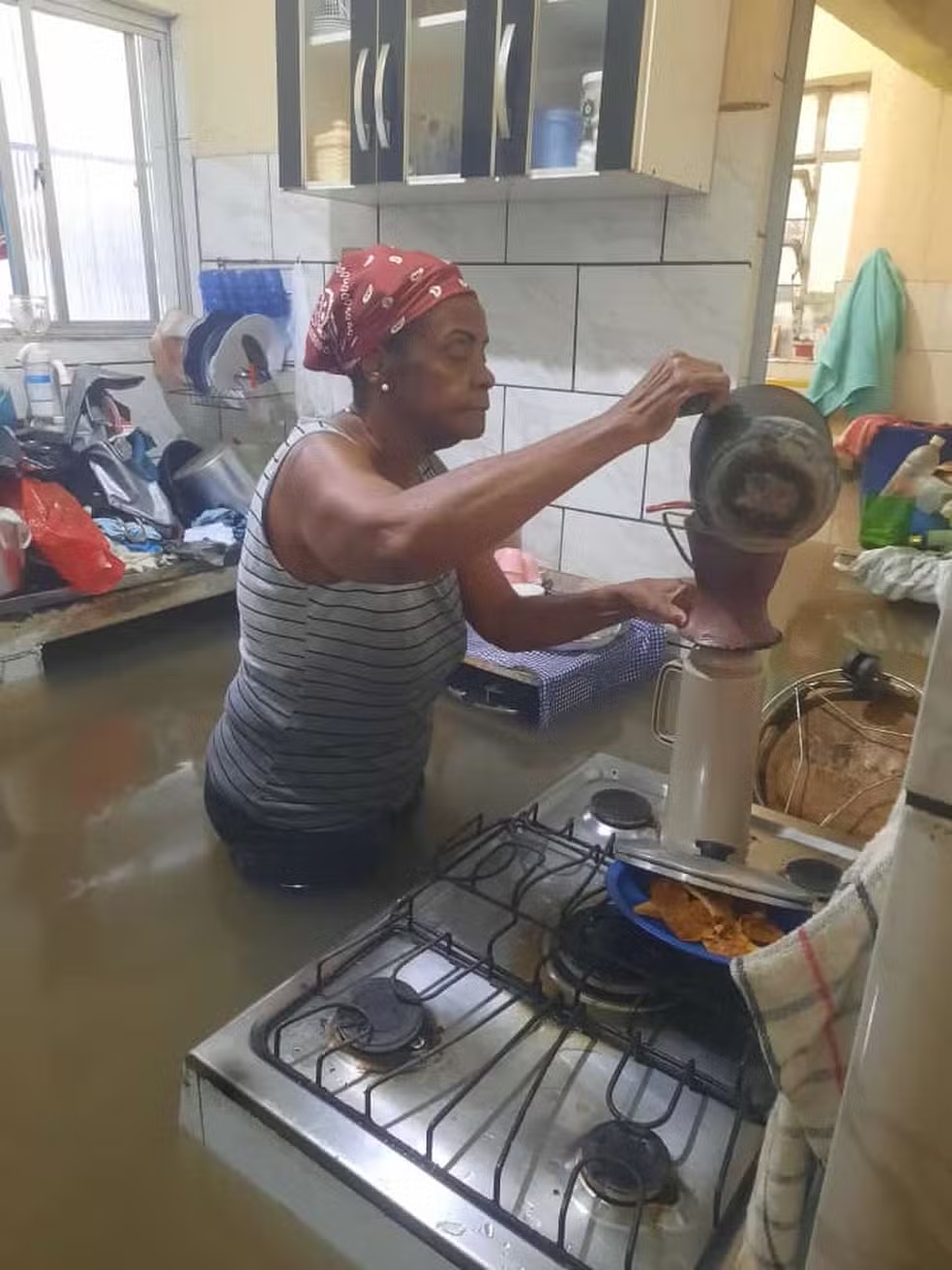
Clique aqui para Português
This article is part of a series created in partnership with the Behner Stiefel Center for Brazilian Studies at San Diego State University, to produce articles for the Digital Brazil Project on environmental justice in the favelas for RioOnWatch. It is also part of RioOnWatch’s ongoing #VoicesFromSocialMedia series, which compiles perspectives posted on social media by favela residents and activists about events and societal themes that arise.
‘Climate Anxiety’ Goes Mainstream
These days in Rio de Janeiro, the temperature is already climbing even before Spring. Plastic swimming pools, once only set up in the summer, become a common presence in the backyards, rooftops, and alleys of favelas, and always earlier than the previous year. Children turn bathing—with a hose, outdoor showers, in water tanks, or streams (which aren’t always clean)—into a game as they spend the day cooling off. In the late afternoon, neighbors bring out chairs to get some fresh air and chat. These scenes are part of the daily life for many of us born in the favelas and peripheries of Rio on hot days.
Despite such strategies to face the scorching heat, the season increasingly brings concerns and leads people to remember and relive the traumas of devastating past summer floods. Though harsh rains are historically common at this time of year, they have become increasingly brutal and frequent due to chronic State negligence and climate change.
Com água perto do pescoço, moradora de Nova Iguaçu faz desabafo ao viver estado de calamidade com enchente pic.twitter.com/Y4MUNcDmAx
— Jornal Destaque Baixada (@jornaldestaqueb) January 14, 2024
Approaches to these events have been the same for decades and have proven repeatedly ineffective. On the news and social media of authorities and public institutions, we are informed that next week’s heatwave will be even stronger. The recommendations are always the same: “drink plenty of fluids,” “put on sunscreen,” “don’t leave the house unprotected.” Certainly all important tips, but what realities are they addressing? Why do they not address the root of the question, or share reproducible and effective solutions to the problem? Who is this message meant to serve?
Dias de muito calor exigem cuidados especiais. Por isso, mantenha-se hidratado, passe protetor solar, use roupas leves e evite atividades físicas ao ar livre no período da tarde. Além disso, se for passear com o pet, prefira as horas mais frescas do dia.
— Prefeitura do Rio (@Prefeitura_Rio) January 16, 2024
Heat waves, floods, and landslides generate more and more fear, uncertainty, and demobilization. Climate emergency experts call this phenomenon climate anxiety. The term is not exactly new, stemming from ecopsychology since the mid-1990s. However, its relevance has become increasingly evident as the debate on climate emergencies advances, imposing significant consequences on our mental well-being. The American Psychological Association (APA) characterizes climate anxiety as “a chronic fear of environmental doom.”
Simplesmente não consigo dormir com a chuva sem dar trégua e às mensagens, vídeos da casa das pessoas alagando.
— Wesley Teixeira (@wesleyteixeiras) January 14, 2024
A survey carried out in February 2020 found that two-thirds of American adults reported feeling at least some level of climate anxiety. Almost half of people under 34 said the stress caused by climate change is already affecting their lives.
Recebi essa imagem de uma moradora do Jardim América, na Zona Norte do Rio, que teve a casa invadida pela chuva. É de cortar o coração. pic.twitter.com/VnZ06NvWg0
— Jonas Di Andrade (@jonasdiandrade) January 14, 2024
Also described as eco-anxiety, climate anxiety is the chronic fear of catastrophes and irreversible environmental changes that affect one’s overall sense of security. It can be characterized by feelings of loss, helplessness, and frustration in the face of environmental impacts, exacerbated by the belief that individual efforts are insignificant compared to the magnitude of the problem.
Já chorei mto e optei por não confrontar esse problema hoje. Doído dms ouvir o tom de tristeza na voz do meu pai no celular pq não conseguiu ajudar a irmã que mora na casa embaixo da nossa. Ela perdeu TUDO.
VÁRIOS familiares meus ficaram com água na cintura e MTO prejuízo 😔— Buba Aguiar (@BuubaAguiar) January 14, 2024
The concept also does not have a single origin. Climate anxiety is a natural human expression that develops organically and has always existed, but it grows as concerns about climate change and the impact of socio-environmental devastation increase.
The Climate Crisis, A Catalyst of Inequalities
In early 2024, environmental scientist and yoga teacher Tainá Antônio published an important reflection on how environmental racism impacts the lives of Black favela residents on her profile. Her post quickly went viral on social media. The scientist revealed that, in Rio de Janeiro, rain is not just a meteorological event but a catalyst of inequalities where some face the cruel reality of losing everything: furniture, cars, and even their own lives or the lives of loved ones.
Ver essa foto no Instagram
The pattern is clear and repeats itself every year, especially in summer, highlighting a correlation between State negligence, territory, and race. It is in the favelas that the face of environmental racism is revealed in the most tragic way. In our context, it is clear who experiences the consequences of climate-related fear and negative mental health impacts most deeply.
Muito louco como as duas coisas estão acontecendo no mesmo momento no Rio de Janeiro
No lado esquerdo um bloco na Zona Sul, no direito uma enchente na Zona Norte pic.twitter.com/Mw1BqupQYH
— Iconografia da História (@IconografiaDH) January 14, 2024
A survey by Brazil’s National Confederation of Municipalities brought to light the extent of the damage caused by rains and droughts in Brazil in 2023: 5.8 million Brazilians were directly impacted, facing human losses, displacement, and considerable economic losses. Extreme weather events already harm infrastructure and the economy, but they also have a profound psychological effect on the lives of millions of citizens. This panorama reinforces the urgency of preventive approaches and adaptation strategies in the face of climate change, aiming to protect vulnerable communities. Given the inevitability of extreme weather events, which will continue to occur with increasing frequency, it is urgent and necessary to build resilient favelas.
Não dá pra ser pobre e periférico e estar de boas com a chuva.
Nossas cidades não foram feitas pra evitar nossa galera de correr risco de vida e perder seus pertences.
Cada vez mais chegam notícias tristes de alagamentos nas ruas e casas.
Precisamos de adaptação climática já!— Thuane (@thuxthuane) January 14, 2024
When considering these climate events, favelas are primarily affected through three main channels: heat waves, flooding rivers, and rising sea levels. A recent study titled Risk Analyses and Climate Vulnerabilities of the Favelas of Maré was conducted by grassroots group Redes da Maré in partnership with Way Carbon. The study highlighted the key risks identified across Maré, the most vulnerable points, the impacts on people’s lives and local infrastructure, and provided examples of measures that can be adopted to mitigate these impacts.
The study proposes tactics to address these processes, such as green roofs. This strategy involves covering roofs with vegetation, which reduces internal temperatures and improves the local microclimate, in addition to filtering rainwater for intelligent water storage systems. The study makes it clear that there is no public policy or solution for communities that can emerge without active listening and participation of residents. It is necessary to map the hardships of the populations living in these areas to understand how to alleviate them. The key is collaboration between public authorities, organized civil society, and communities. Only through this approach can efficient actions be consolidated to mitigate the impacts of climate emergencies in favelas and urban peripheries.
Ver essa foto no Instagram
In our context, in Rio de Janeiro, climate anxiety is not just an emotional state, but an echo of environmental racism and historic socio-environmental inequalities. As we face imminent catastrophes, eco-anxiety urges us to rethink our role in protecting the planet and creating more resilient communities. Just like pathological anxiety, which, when accompanied by a therapist, amplifies our ability to concentrate and can motivates us, climate anxiety should be treated in the same way. Public health facilities, such as family clinics, should prepare to offer treatment options to residents of climatically vulnerable areas.

From this perspective, it is essential to analyze the risks and vulnerabilities of each favela and create solutions for the collective problem known today as climate anxiety. The path forward is a combination of grassroots collective actions to raise socio-environmental awareness, and an interdisciplinary range of public policies aimed at everything from infrastructure, health, environment, humanitarian relief, crisis management efficiency, to restoration efforts. Without these measures, overcoming the challenge of collective health in favelas and peripheries will not be possible.
View this post on Instagram
About the author: Cleyton Santanna holds degrees in journalism and screenwriting from Federal Rural University of Rio de Janeiro (UFRRJ) and the CriaAtivo Film School. He uses his YouTube channel to address oddities, ancestry, and Afro-Brazilian culture. In 2017, he produced two documentaries: “Entre Negros” (Between Blacks) and “Tudo Vai Ficar Bem” (Everything is Gonna Be OK), and was recognized as a screenwriter in 2018 by the Creative Economy Network for the short “Vandinho.” He is currently a communicator for the Museum of Tomorrow and hosts the Influência Negra podcast.

